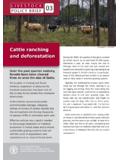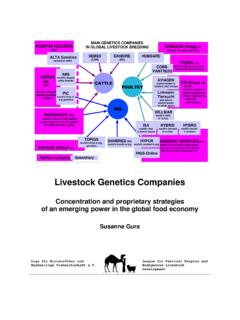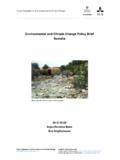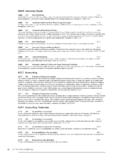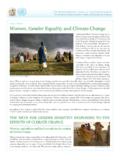Transcription of LIVESTOCK IN THE BALANCE - Food and Agriculture ...
1 LIVESTOCK IN THE BALANCE534. LIVESTOCK and the environmentLivestock production systems and ecosystemsThe interaction of LIVESTOCK with ecosystems is complex and depends on location and management practices. Most traditional LIVESTOCK production systems are resource-driven in that they make use of locally available resources with limited alternative uses or, expressed in economic terms, low opportunity costs. Examples of such resources include crop residues and extensive grazing land not suitable for cropping or other uses. At the same time, in mixed production systems, traditionally managed LIVESTOCK often provide valuable inputs to crop production , ensuring a close integration between the rising demand for LIVESTOCK products is changing the relationship between LIVESTOCK and natural resources.
2 Modern industrial production systems are losing the direct link to the local resource base and are based on bought-in feed. At the same time, some of the resources previously available to LIVESTOCK at a low cost are becoming increasingly costly, either because of growing competition for the resources from other economic sectors and other activities (such as production of biofuels; see Box 10) or because society is placing greater value on the non-market services provided by these resources (such as water and air quality).The separation of industrialized LIVESTOCK production from the land used to produce feed also results in a large concentration of waste products, which can put pressure on the nutrient absorptive capacity of the surrounding environment.
3 In contrast, grazing and mixed farming systems tend to be rather closed systems, in which waste products of one production activity (manure, crop residues) are used as resources or inputs to the LIVESTOCK sector is also a source of gaseous emissions that pollute the atmosphere and contribute to the Policy action is required to mitigate the impact of LIVESTOCK production on the environment and to ensure that the sector makes sustainable contributions to food security and poverty reduction. LIVESTOCK production , like any economic activity, can be associated with environmental damage.
4 Unclear property rights and the lack of adequate governance of the LIVESTOCK sector can contribute to the depletion and degradation of land, water and biodiversity. At the same time, the LIVESTOCK sector is affected by the degradation of ecosystems and faces increasing competition for these same resources from other sectors. Climate change represents a special feedback loop , in which LIVESTOCK production both contributes to the problem and suffers from the consequences. Unless appropriate action is taken to improve the sustainability of LIVESTOCK production , the livelihoods of millions of people will be at LIVESTOCK sector suffers from market and policy failures at many levels, including problems associated with open-access resources, externalities and perverse incentives that encourage damaging practices.
5 While some countries have made progress in reducing pollution and deforestation associated with LIVESTOCK production , many more require appropriate policies and enforcement capacity. Given the likely continued strong growth in global demand for LIVESTOCK products and the reliance of many people on LIVESTOCK for their livelihoods, there is an urgent need to enhance the efficiency of natural-resource use in the sector and to reduce the environmental footprint of LIVESTOCK production . Given better management practices, the LIVESTOCK sector can reduce its footprint and contribute substantially to climate change mitigation.
6 Achieving these objectives requires action on policy, institutional and technical STATE OF FOOD AND Agriculture 200954greenhouse effect. Continued growth in LIVESTOCK production will exacerbate pressures on the environment and natural resources, calling for approaches that allow for increased production while lowering the environmental and landLivestock is the world s largest user of land resources, with grazing land and cropland dedicated to the production of feed representing almost 80 percent of all agricultural land. The sector uses billion hectares for grazing (Table 12) and billion hectares for feed crops (Steinfeld et al.)
7 , 2006); the latter figure corresponds to one-third of total total land area occupied by pasture is equivalent to 26 percent of the ice-free terrestrial surface of the planet. Much of this area is too dry or too cold for cropping, and is only sparsely inhabited. Management practices and use of pastureland vary widely, as does the productivity of LIVESTOCK per hectare. In arid and semi-arid rangelands, where most of the world s grasslands BOX 10 Expansion of biofuels productionGrowing use of cereals and oilseeds to produce fossil fuel substitutes ethanol and biodiesel represents a significant challenge for the LIVESTOCK sector in terms of competition for resources.
8 The global biofuel industry has experienced a period of extraordinary growth, driven by a combination of high oil prices, ambitious goals for use of renewable energy set by governments around the world and subsidies in many OECD rapid growth has had important consequences for the price and availability of crops, such as maize and oilseed rape, that are used as biofuel feedstocks. Most studies to date have focused on impacts on the crop sector. However, the LIVESTOCK sector has also been strongly affected. The most obvious consequence of large-scale liquid biofuel production for the LIVESTOCK industry is higher crop prices, which raise feed costs.
9 Biofuel production also increases returns to cropland, which encourages conversion of pastureland to the other hand, producing biofuels creates valuable by-products, such as distillers dried grains with solubles (DDGS) and oilseed meals, that can be used as animal feed and can substitute for grain in animal rations. production of these by-products has increased dramatically in recent years as a result of the boom in biofuel production . The prices of these by-products have fallen relative to other feedstuffs, and, as a result, they have been increasingly used in feeds in some countries and production suggests that biofuel by-products have helped to offset some of the adverse cost implications of the biofuels boom for the LIVESTOCK industry.
10 At the same time, biofuel by-products represent an important component of biofuel industry revenues. If the LIVESTOCK industry could not absorb these by-products, their prices would fall sharply, thereby making biofuel less economically impact of large-scale biofuel production on the LIVESTOCK industry varies across regions and across LIVESTOCK types. The strongest impact is being felt in those countries that are actively pursuing efforts to increase biofuel use ( the United States of America and countries of the European Union), as well as those countries that are closely tied into the global agricultural economy.










